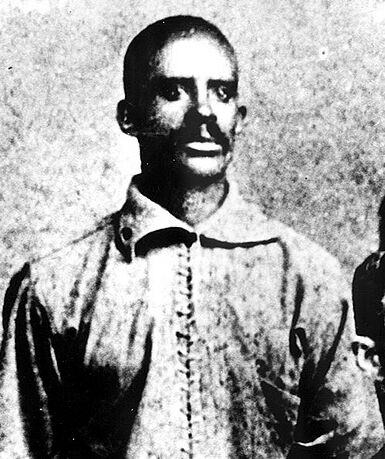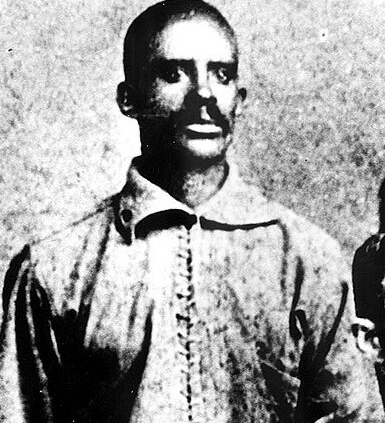August 6, 1887: Bud Fowler joins the Montpelier Capital Citys
 Black baseball pioneer and 2022 Hall of Famer Bud Fowler played for at least 15 minor-league teams from 1878 to 1895, and he’s considered the first acknowledged African American professional baseball player.1 One stop on his journey was with the Montpelier Capital Citys of the 1887 Northeastern League. Throughout his historic career, Fowler was the target of racism from fans, opponents, and teammates, but it appears that he was admired and respected during his stint in Vermont, where he was the only Black man on the field.
Black baseball pioneer and 2022 Hall of Famer Bud Fowler played for at least 15 minor-league teams from 1878 to 1895, and he’s considered the first acknowledged African American professional baseball player.1 One stop on his journey was with the Montpelier Capital Citys of the 1887 Northeastern League. Throughout his historic career, Fowler was the target of racism from fans, opponents, and teammates, but it appears that he was admired and respected during his stint in Vermont, where he was the only Black man on the field.
The Capital Citys were one of five teams in the Northeastern League, a circuit informally called the “Vermont State League.” It had four teams based in Vermont (Burlington, Montpelier, Rutland, and St. Albans) and a team in Malone, New York. The eight-person board of directors managing the Capital Citys sold stock at $5.00 a share to fund the team’s expenses and convert part of Nicholas Meadow into an enclosed ballpark with seating for spectators.2
Fowler started the 1887 season with the Binghamton Crickets of the International Association and was one of the best players in the league, tallying 55 hits in 34 games. But he faced significant tension from his White teammates. On June 27 Buck West and Charles Dilworth refused to play with Fowler and asked to be released from their contracts. Nine other Binghamton players signed a petition to have Fowler released from the team, and Fowler was dismissed.
An opposing International Association player said, “Fowler used to play second base with the lower part of his legs encased in wooden guards. He knew that about every player that came down to second base on a steal had it in for him and would, if possible, throw the spikes into him.”3 Additionally, league umpire Billy Hoover admitted to purposely calling close plays against Fowler’s teams.4 Fowler also heard racial epithets shouted from the stands.
On July 14, 1887, International Association executives met in Buffalo, New York, and voted not to approve the contracts of any more Black players. That same day, Chicago White Stockings manager Cap Anson said his National League team would not play an exhibition game against the International Association’s Newark Little Giants if Newark’s Black pitcher George Stovey and Black catcher (and former major leaguer) Fleet Walker were on the field. This is considered the day the major leagues’ color line was drawn and it would be 60 years before another African American played alongside White players in the major leagues.5
In early August, newspapers across Vermont noted that the Northeastern League club in Montpelier had signed Fowler.6 His first game was on August 6 at Nicholas Meadow against St. Albans. Nicholas Meadow was a vast, well-groomed field across the Winooski River from Montpelier’s lower State Street.7 It hosted numerous events that month, including the Barnum and London circus.8 Office buildings and Montpelier High School’s athletic fields now occupy the wide plot of land.9
The field was wet at the beginning of the game due to morning rain.10 Errors by Montpelier helped Lawrence Downey and J.E. Rudderham score runs for St. Albans in the first inning. In the second, Fowler singled, stole second, stole third, and scored on a base hit to center field to make it 2-1. Harry Wright scored for St. Albans in the fifth, Larimer did the same for Montpelier in the sixth, and neither team scored the rest of the way in St. Albans’ 3-2 win.11
Montpelier’s Argus and Patriot newspaper singled out Fowler, writing that “the man who covered himself with glory was the recent acquisition of the Montpelier team, John Fowler, colored, of New York. … He played a great game at second base.”12 While Fowler made an error in the close loss, multiple media reports described the loud ovation he earned after an acrobatic relay throw in the middle of a 5-4-3 double play in the eighth inning.13
One week later, Fowler went 4-for-5 and made seven putouts in Montpelier’s 10-6 loss at St. Albans and the Burlington Free Press reported: “Fowler, the colored second baseman, captured the crowd by his fine playing.”14
Similar praise for Fowler followed other Montpelier games, like this appreciation from the Argus and Patriot: “with Fowler, the phenomenal colored second baseman, the Montpelier club are only too well pleased to have him guarding the second bag.”15
That same paper welcomed the idea of more Black players coming to town in 1887, writing that “if Binghampton [sic] or any other club has any more Fowlers, Montpelier can find a place for them.”16
Fowler was named co-captain of the Capital Citys in mid-August.17 According to Jeffrey Michael Laing’s biography Bud Fowler: Baseball’s First Black Professional, Fowler was “the first (and only) African American to serve in that position in organized integrated baseball in the 19th century. What is surprising about the veteran’s appointment to this role is how uncontroversial such an action was in Vermont in the racially charged 1880s.”18
A co-captain’s responsibilities in this era varied from team to team, but it appears likely that Fowler contributed to scheduling and lineup decisions with co-captain H.J. Cox and managers William Lord and Fred Spaulding.19 He was also a vocal leader; in a game against Burlington on August 17, Fowler exclaimed to his team, “The game is ours, all we have got to do is to bat it out!”20
It’s impossible to know how all of the White Capital Citys players felt about Fowler’s promotion to co-captain, but there’s no evidence that any of them refused to take direction from Fowler. The Argus and Patriot applauded the team’s acceptance, writing “The management of the Montpelier base ball club have at least one thing upon which they can congratulate themselves, and that is that there appears to be no race prejudice among the players.”21
After Montpelier’s 13-4 loss in Rutland on August 16, the Rutland Daily Herald wrote, “Captain Fowler of the Montpeliers is a colored man and a first-class ball-tosser in every respect. He played a brilliant game yesterday on second and made two of the four runs for his club. The Montpeliers are fortunate in securing him. … Fowler seemed to be the favorite with the spectators yesterday, and was greeted with applause every time he stepped to the plate.”22
Fowler hit .429 with seven stolen bases in his eight official documented games with Montpelier23 and seemed to have been popular.
Fowler’s time in Vermont’s capital city ended abruptly. The club couldn’t meet player payroll due to financial difficulties,24 and folded before the 1887 season ended. Looking for another team to play for, Fowler traveled east to New Hampshire and joined a professional club in Laconia.
The Montpelier Capital Citys finished their only season with a 2-13 record.25 Three members of the team ended up playing in the major leagues.26 Fowler wasn’t one of them, but that wasn’t due to a lack of ability.
Sources
In addition to the sources cited in the Notes, the author used Baseball-Reference.com and Newspapers.com, and received research assistance from Charlie Bevis, Paul Carnahan, Wayne McElreavy, Chuck McGill, and Tom Simon.
Notes
1 Brian McKenna, “Bud Fowler,” SABR BioProject, https://sabr.org/bioproj/person/bud-fowler/.
2 “Montpelier and Vicinity,” Vermont Watchman and State Journal, June 29, 1887: 1; “Business Notices,” Rural Vermonter, July 1, 1887: 3.
3 Ron Thomas, “Black Innovations Enriched Baseball,” San Francisco Chronicle/Des Moines Register, March 28, 1993: 31.
4 “Bud Fowler.”
5 Peter Mancuso, “July 14, 1887: The Color Line Is Drawn in Baseball,” Society for American Baseball Research, https://sabr.org/gamesproj/game/july-14-1887-the-color-line-is-drawn/.
6 “Base Ball,” Vermont Watchman and State Journal, August 10, 1887: 1.
7 “Business Notices,” Vermont Watchman and State Journal, July 20, 1887: 1.
8 “The Barnum and London Show,” Vermont Watchman and State Journal, August 3, 1887: 1.
9 Paul Carnahan, “Langdon Meadow and the Growth of Montpelier,” The Bridge, December 1, 2016.
10 AccuWeather, email correspondence with certified consulting meteorologist Steve Wistar, November 13, 2021.
11 “Base-Ball,” Vermont Watchman and State Journal, August 10, 1887: 1.
12 “Base Ball at Montpelier Last Week,” Montpelier Argus and Patriot, August 10, 1887: 4.
13 “Base Ball at Montpelier Last Week.”
14 “The World of Sports,” Burlington Free Press, August 15, 1887: 1.
15 “Mere Mention Memoranda,” Montpelier Argus and Patriot, August 17, 1887: 4.
16 “Mere Mention Memoranda.”
17 “Base-Ball,” Vermont Watchman and State Journal, August 17, 1887: 1.
18 Jeffrey Michael Laing, Bud Fowler: Baseball’s First Black Professional (Jefferson, North Carolina: McFarland, 2013), 96.
19 “Montpelier Minor Mere Mention,” Montpelier Argus and Patriot, July 13, 1887: 3.
20 “Burlingtons Win,” Burlington Free Press, August 18, 1887: 8.
21 “Mere Mention Memoranda.”
22 “Field Notes,” Rutland Daily Herald, August 17, 1887: 4.
23 Bud Fowler: Baseball’s First Black Professional, 96.
24 “Base Ball Trouble at Montpelier,” Burlington Free Press, August 11, 1887: 8.
25 Lloyd Johnson and Miles Wolff, Encyclopedia of Minor League Baseball (Durham, North Carolina: Baseball America, 2007), 149.
26 “History / Baseball in Central VT,” Vermont Mountaineers, http://thevermontmountaineers.pointstreaksites.com/view/thevermontmountaineers/mountaineers-history-1/history-baseball-in-central-vt.
Additional Stats
St. Albans 3
Montpelier Capital Citys 2
Nicholas Meadow
Montpelier, VT
Corrections? Additions?
If you can help us improve this game story, contact us.


